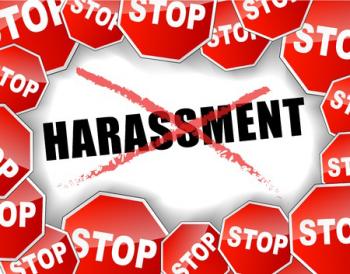Latest News
- Bay Area Employers: Shelter in Place Order Extended
(posted: Apr, 2020)SIP extended through May 31st. The SF Bay Area will continue to shelter in place through the end of May, even as other parts of the U.S. begin to reopen.
Latest Blog
- Bay Area Counties Issue New Order, SIP thru May
(posted: Apr, 2020)
The 6 counties are extending SIP through the end of May, but are also easing restrictions in a few key areas like construction.
CA Employers: Review Guidance on Handling Workplace Harassment Claims
(posted: November 5th, 2018)

In the #MeToo and #TimesUp era of sexual harassment scandals, more people may be coming forward with claims against their employers. California businesses should note state-specific harassment prevention rules and recommendations, which are covered in a comprehensive state guide, here.
The document was developed jointly by the California Department of Fair Employment and Housing (DFEH) and the California Task Force on the Prevention of Sexual Harassment in the Workplace. It covers a lot of ground, including topics that can be confusing for employers, such as confidentiality, credibility, burden of proof and the type of questioning that should be used in a complaint investigation.
The DFEH also has a brochure that discusses ways to prevent and correct misconduct.
Anti-Harassment Program Components
We'll walk through some of the areas touched on in the guide.
According to the guide, an effective anti-harassment program should include:
- A written policy. The policy should be distributed to all workers, and it should be regularly discussed at company meetings.
- A good workplace culture. Managers should be role models of appropriate behavior.
- Training for supervisors. Businesses with 50 or more employees must train supervisors on sexual harassment prevention. Under A.B. 1825, businesses must provide two hours of this training once every two years. Effective in January 2015, A.B. 2053 expanded this training to include how to prevent abusive conduct. And beginning in January 2018, under S.B. 396, the training will need to include gender identity, gender expression and sexual orientation harassment prevention. In 2020 DB 1343 modifies the AB 1825 requirements to 5 or more employees, and adds an hour of training every two years for non-supervisory personnel.
- Training for complaint-handlers.
- Policies for responding to and investigating complaints.
- Prompt, thorough, and fair complaint investigations.
- Prompt and fair remedial actions.
Managing Complaints and Investigations
The employee making the complaint shouldn't be required to report the complaint to his or her immediate supervisor. The employee should be able to report it in multiple ways, including by telling a company-designated contact (such as an HR manager or department executive), calling a complaint hotline, or telling an ombudsperson.
If an employer receives a report of misconduct, it should determine whether the behavior is serious enough to merit conducting a formal investigation.
During an investigation, companies must be fair to each party by following these steps:
- Interviewing the person who made the complaint, ideally in person.
- Giving the accused party an opportunity to respond, ideally in person.
- Interviewing witnesses and reviewing any relevant documents.
- Making a fair conclusion.
Confidentiality
The issue of confidentiality can be confusing for employers, as it is not something that can be fully guaranteed.
According to the guide, companies can only promise limited confidentiality and that the information will be shared with those who must have it; in order to conduct a thorough investigation, there are going to be people who need to know.
During the investigation, it's likely that people will know or assume specific details about the allegations. Also, the person receiving the complaint typically will need to discuss the claim with others in the company.
The Investigator
Companies should make sure the investigator is qualified and trained. Investigators should have strong communication skills, understand relevant laws and policies, know how to question witnesses and document interviews, and know how to analyze information.
Investigators can get training from various sources, such as organizations for HR professionals, associations for workplace investigators, and enforcement agencies.
The person investigating the complaint must determine whether he or she has any biases that would interfere with reaching a fair conclusion. Even the appearance of bias is problematic.
For instance, if the investigator is friends with either party, whether it's an actual friendship or a perceived friendship, the investigator might need to recuse him- or herself.
Employers can use either an internal investigator or an external investigator. If the allegations are being made against a powerful person at the company, as in the Harvey Weinstein situation, it's a good idea to use an independent investigator.
Credibility
Many times, there are no witnesses to an alleged harassment incident other than the accused and the accuser. When the parties disagree about what happened, investigators need to weigh the credibility of each party's account.
The investigator can use many credibility factors, including inherent plausibility and motive to lie. From the guide: "For example, a complainant who complains about harassment may have been seen to be upset shortly after the event, or may have told someone right after the event. This would tend to bolster his or her credibility."
E-mails or text messages might also bolster or reduce a witness's credibility.
Making credibility determinations based on a person's demeanor, however, may not be the best approach. A person's outward behaviors, such as facial expressions, body language and tone of voice, may be exhibited for a variety of reasons that are unrelated to the investigation.
For example, not making eye contact might be perceived as a red flag, but some people avoid eye contact for cultural or other reasons.
It is best to make credibility determinations based on the objective evidence.
Drawing Conclusions
Investigators should use the "preponderance of the evidence" standard that is used in many civil cases. This is also known as the "more likely than not" standard.
According to the guide, this means that the investigator makes a finding that it's "more likely than not" that the alleged misconduct occurred or "more likely than not" that it didn't occur.
Investigators should draw factual conclusions, not legal conclusions.
"Sometimes, internal investigators will also reach a conclusion regarding whether behavior did or did not violate a company policy. Note that violating a workplace policy is a different standard than violating the law, which is one reason that investigators should not make legal findings."
Employers should ensure that workers aren't retaliated against for bringing harassment complaints. Also, they should impose a remedial action that is "commensurate with the level of misconduct and that discourages or eliminates recurrence," according to the guide. Appropriate remedial measures may include training, counseling, a demotion and termination.
We suggest downloading and reading the guide, then implementing the recommendations. Of course, we are here to help! Please contact us with your workplace harassment questions and concerns.



